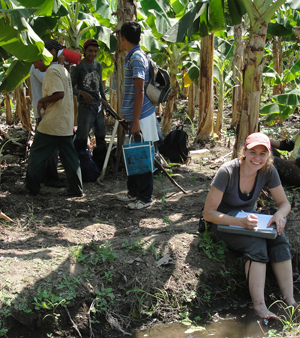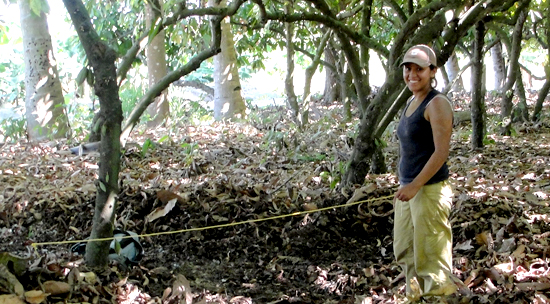UAlbany Students Peel Back the Layers of Early Human Development
Graduate student Yahaira Nuñez measures a grid for study at UAlbany's Soconusco Project site in Mexico.
ALBANY, N.Y. (March 16, 2011) --
On the Pacific coast of Mexico, UAlbany students are at work examining an early agricultural settlement. Through the project, headed by Assistant Professor of Anthropology Robert M. Rosenswig, students conduct their own research and receive the necessary experience to apply for archaeology jobs with state and federal government. More importantly, these students are helping advance understanding of how the humans transitioned from hunter/gatherer societies to farming cultures and the earliest states in Mesoamerica.
Rosenswig recently received a $280,000 grant from the National Science Foundation to continue his research in the Soconusco region of the Mexican state of Chiapas, near the site of the pre-Columbian ruins of Izapa. His team includes researchers like UAlbany graduate student Marx Navarro and UAlbany alum Daniel Seinfeld.
 |
UAlbany doctoral student Rebecca Mendelsohn will base her dissertation on research collected at the Soconusco site. |
Seinfeld, who graduated from UAlbany in 2003, took part in his first UAlbany archaeology field school in Belize in 2002. He has just completed his dissertation in archaeology at Florida State University based on data collected by Rosenswig through the 2005 and 2008 UAlbany field schools at the site of San Estevan in northern Belize. Sienfeld is one among many UAlbany graduates who have turned a field school experience into a career.
"At its most basic level, the proposed research asks: how did our stratified world evolve from the egalitarian hunter-gatherers that constitute most of human history?" said Rosenswig. "After over 100,000 years of the existence of modern humans on earth, hierarchical forms of political organization emerged around the world during the past 5000 years. Power and hierarchy are fundamental issues addressed by many social sciences and archaeologists are in a unique position to explore the origins and development of the institutionalized hierarchy that permeates modern life."
The broader impact of this research is to document the political history of Izapa, and increase awareness of archaeological resources in the region as well as contribute to local and national Mexican cultural heritage. Navarro will help in this endeavor by developing teaching materials and organizing an outreach program to local schools. Navarro, who was born and raised in the nearby city of Tapachula, can also serve as a role model for children in the Soconusco region.
In addition to Navarro and Seinfeld, current UAlbany graduate students Caroline Antonelli and Rebecca Mendelsohn will base their dissertations research on data collected by the Soconusco project. Further, Sean Higgins, who received in master's degree under Rosenswig's direction in 2009, is participating on the project.
The project has also helped advance the careers of international students such as Yahaira Nuñez, who is from Costa Rica and has applied for a Fulbright fellowship to come and study archaeology at UAlbany in the fall.
![]() For more news, subscribe to UAlbany's RSS headline feeds
For more news, subscribe to UAlbany's RSS headline feeds
Educationally and culturally, the University at Albany-SUNY puts "The World Within Reach" for its 18,000 students. An internationally recognized research university with 58 undergraduate majors and 128 graduate degree programs, UAlbany is a leader among all New York State colleges and universities in such diverse fields as public policy, nanotechnology and criminal justice. With a curriculum enhanced by 300 study-abroad opportunities, UAlbany launches great careers. For more information about this globally ranked University, visit https://www.albany.edu/. For UAlbany's extensive roster of faculty experts, visit www.albany.edu/news/experts.shtml.




